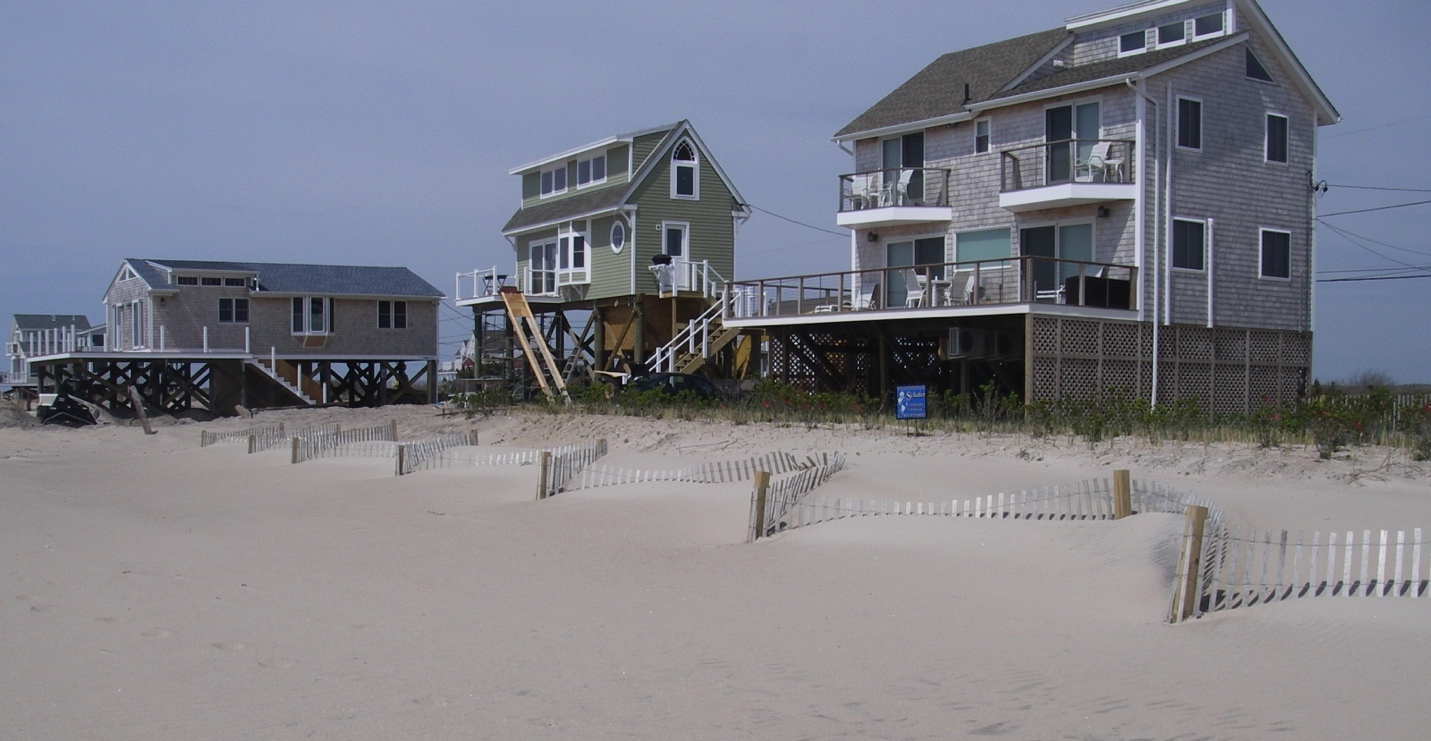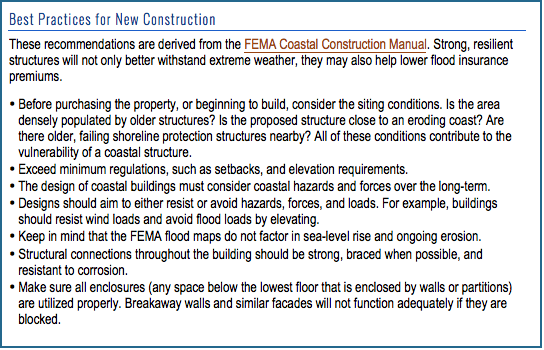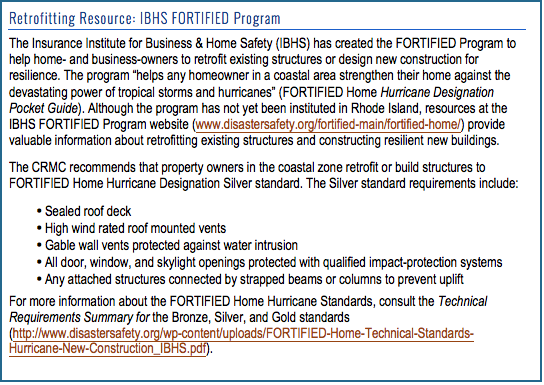Resilience
10. Can I make the existing building more resilient? How do I build a new resilient structure?
If the existing building is especially vulnerable to coastal hazards or does not meet the most recent standards for building in the coastal zone (Question 8: How do I determine if the buildings on the property meet the current design and construction standards for the flood zone?), it may be possible to retrofit the structure to increase resiliency. If a structure requires repairs following a coastal storm or flood event, it is recommended that owners incorporate resilience measures in the renovation process.
- Elevating – raising the structure so that it is above the base flood elevation (BFE) for the area. State building code requires new and substantially improved construction in the flood plain to be raised one foot above BFE, but increasing the freeboard (the space between the BFE and the lowest floor of the structure) will help reduce risk.
- Retrofitting or reinforcing – using methods such as hurricane shutters, flood vents, flood-resistant materials or other techniques to protect the structure.
- Retreat or relocation – moving the structure back from the shoreline. CRMC regulations require certain setbacks based on erosion rates and coastal features – exceeding these setbacks may reduce risk and prolong the life of the structure.
- Repairing previously damaged structures – if structures have been damaged due to coastal hazards, repairing them quickly will prevent increased vulnerability in the face of the next coastal weather event.
- Replacing or repairing the structure’s roof – a large portion of storm-related damage is associated with roof failures. Replacing an older roof with a sealed, structurally sound roof could reduce potential storm-related damage by half.
RECOMMENDATION FOR BUYERS: If you intend to update or otherwise alter an existing structure, develop a plan to renovate or retrofit before buying. Weigh costs of improvements against flood insurance premiums, risk, and vulnerability. Buyers can obtain elevation certificates based on a proposed project in order to get flood insurance estimates for the renovated structure.

Elevated homes in Westerly, R.I. The green house (center) has been elevated to 5 feet above the base flood elevation.
New Construction in the Coastal Zone
In addition to adhering to local building codes, new development in the coastal zone must meet specific criteria in regards to flood resistant and load-bearing construction as per the CRMC and the NFIP. The loads that need to be considered for coastal construction are wind loads, flood loads, breaking wave loads, and debris-impact loads.
Flood-provisions in the state’s building code address elevation regulations, siting practices, the use of flood-resistant materials, and other design requirements for residential and commercial buildings in flood-prone areas. For information about Rhode Island’s current building codes and standards, please visit the state’s Building Code Commission website.

Find out more: For more information about building in the SFHA, please see Section 300.3, Part G – Guidelines for Construction in Flood Hazard Zones in the R.I. CRMC regulations.
For additional information about retrofitting, rebuilding, and constructing in the coastal zone, please consult the following resources:
- CRMC Rebuilding after the Hurricane
- FEMA Coastal Construction Manual
- FEMA Building Code Resources
- 2012 International Building Code – Flood Resistant Provisions
- Highlights of ASCE 24-05 Flood Resistant Design and Construction (2010)
- FEMA Homeowner’s Guide to Retrofitting
- Chapter Five: Elevating Your Home
- FEMA Wind Retrofit Guide for Residential Buildings
- Floodplain Management in Rhode Island: 2007 Quick Guide
- International Code Council: Hurricane Safety
- IBHS FORTIFIED Program
- FORTIFIED Home 2012 Hurricane Standards
- Is your roof FORTIFIED?
NEXT: Resources & Links >>
This website has been prepared by the University of Rhode Island’s Coastal Resources Center and Rhode Island Sea Grant for the R.I. Coastal Resources Management Council as a guidance resource. It is not intended nor should be used to give any legal advice nor to supersede any state or federal statutory or regulatory language or interpretation of such language. This website refers the reader to various regulations and policies adopted by federal and state regulatory agencies; the reader is encouraged to review the specific regulation and policy.
Rhode Island Coastal Property Guide Credits & Acknowledgements

